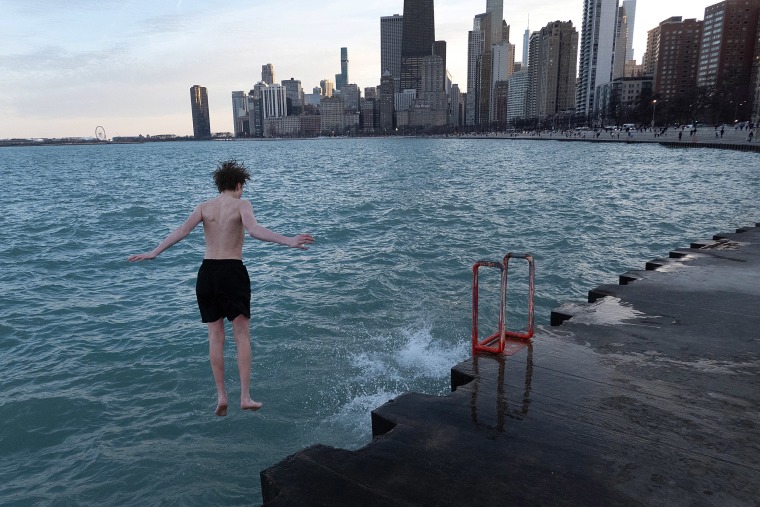 NBC NewsRecord heat, tornadoes and snowstorms: Roller coaster of temperatures
forecast across the U.S.
NBC NewsRecord heat, tornadoes and snowstorms: Roller coaster of temperatures
forecast across the U.S.
Millions of Americans will experience a tale of two seasons this week, beginning with spring and summerlike warmth but ending with a bitter blast back to reality with more winterlike temperatures to end the month.
On Monday, daily, monthly and seasonal record highs were all set at a blistering pace with the warmth stretching from the Canadian border to the Gulf Coast. All in all, more than 100 daily record highs and more than 30 monthly records were set.
On Tuesday, 50 to 80 additional daily record highs could be set from the Great Lakes to the Gulf Coast, eastbound into the Northeast. Highs will be 15 to 35 degrees above average, with isolated locations soaring to 40 degrees above average.
The high temperatures experienced over the past couple of days are more typical of June, including for the Chicago area, which is forecast to reach the mid-70s.
By Wednesday, however, a dramatic temperature tumble, associated with a powerful cold front, will slice across the country, leaving bitter cold temperatures in its wake.
High temperatures Wednesday across the Upper Midwest and Plains will be 25 to 50 degrees colder compared to Tuesday. Places like Chicago will go from a high in the 70s to wind chills in the teens and single digits by Wednesday morning.

Dallas, after hitting the mid-90s Monday and near 90 again Tuesday, will experience a high of just 55 degrees Wednesday.
It will be a true temperature roller coaster for millions, with the potential for more record warmth returning Saturday, especially across the Midwest and Great Lakes.
The same powerhouse cold front that will drop temperatures across the country will also bring the risk of severe thunderstorms capable of destructive hail and nocturnal tornadoes to the Midwest and Great Lakes on Tuesday.
Forty million people are under the risk for severe storms from Missouri to Michigan, where very large hail (up to golf ball size or larger) and isolated tornadoes are the main risks, followed by damaging winds. The storms are expected to initiate late in the afternoon and perhaps after sunset and continue charging east through the overnight hours.
Cities on guard for severe weather through Wednesday morning include Chicago, St. Louis, Indianapolis, Detroit, Cleveland, Cincinnati and Louisville, Kentucky.
When breaking down the specific hazards possible, the greatest chance for damaging hail is forecast for northern Illinois and extreme southeastern Wisconsin.
While tornadoes are possible across the entire risk area, the more localized region that could see the potential for a strong tornado or two is along the Ohio River. All areas from Louisville, Kentucky, to Evansville, Indiana, and stretching to the western edge of the Cincinnati metro area should be on high alert for the potential for tornado-producing storms that could occur after sunset.
A tornado and large hail risk this far north in February is uncommon, with the typical regions experiencing severe weather this time of year being the Southeast and Gulf Coast states.
Forecasters cautioned that Tuesday's severe thunderstorm setup is a complex one, with a lower-than-average confidence on when and where the severe thunderstorms may break out. This was due to some uncertainty in where necessary ingredients like warmth, moisture and wind shear (winds changing speed and direction with height) will overlap to bring the greatest threat.
Regardless, one certainty in the severe thunderstorm setup is that it will be fueled by the record-setting temperatures that are more common in the spring and early summer than in late February.
On Wednesday, heavy rain and wind will affect the East Coast, including the I-95 corridor around the evening rush hour.
While the severe threat will be lower, the timing of the storms could cause travel delays on the road and in the air.
Behind this strong storm system as the temperatures turn sharply colder, some areas may end with snow squalls Wednesday night into Thursday morning, with the highest likelihood being in and around the Great Lakes region.
City timing
- Chicago: Severe storms possible Monday from 6 p.m. to 11 p.m., then rain/snow mix lasting through 8 a.m. Wednesday.
- Cincinnati: A couple rounds of strong to severe storms possible Monday, with the best chance after 10 p.m.
- Washington, D.C.: Heavy rain and wind will occur Wednesday from 1 p.m. to 6 p.m. with gusts up to 35 mph possible.
- New York: On-and-off rain showers will begin later Monday, but the heaviest rain and wind will be Wednesday from 5 p.m. to 9 p.m. along with wind gusts up to 40 mph.
March will come in like a lion for California
As soon as the current storm system moves out by late Wednesday, a new storm system coming off the Pacific will bring the potential for 5 to 12 feet of snow across the Sierra beginning Thursday night and lasting into Sunday morning.
This could be the Sierra’s biggest snowstorm of the season so far and help make up the current snowfall deficit for the mountain chain.
The snow, however, could be intense at times, which would cause dangerous travel conditions and snow load stress to infrastructure.



No comments:
Post a Comment